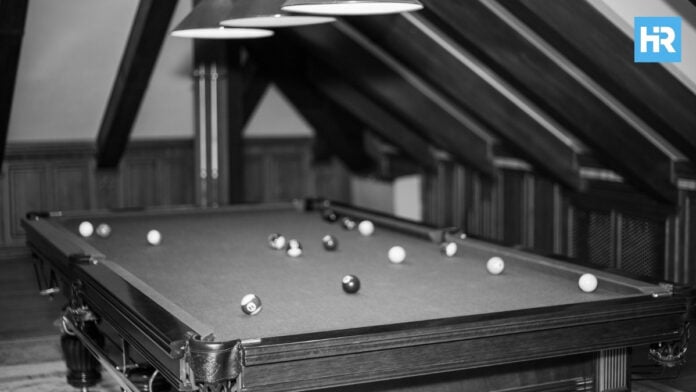Billiards, a game played by kings, commoners, presidents, mental patients, ladies, gentlemen, and hustlers, originated as a lawn game in 15th-century Northern Europe, likely in France. According to Mike Shamos, Curator of The Billiard Archive, the game eventually moved indoors. The indoor version was played on a wooden table covered in green cloth to resemble grass, with a simple border to keep the balls in play.
The balls were initially pushed with wooden sticks called “maces.” The word “billiard” is derived from either the French word billart, meaning one of the wooden sticks, or bille, meaning ball. In time, the mace was replaced by the cue stick. This transition began in the late 1600s when players found it difficult to use the large-headed mace near the edge of the table. They began using the handle of the mace, called the “queue” (meaning tail), to strike the ball.
In early play, only men were permitted to use the cue. Women were required to use the mace, based on the belief that they were more likely to rip the cloth with the sharper cue tip.
Originally, billiard tables had flat walls known as “banks,” whose only function was to keep balls from falling off. Players discovered that balls could bounce off the rails and began aiming at them intentionally. This led to the development of the “bank shot,” where a ball is rebounded from a cushion as part of the shot.
- Billiards began as a lawn game in 15th-century Europe and evolved indoors with the help of royalty, green cloth tables, and early cue sticks called maces.
- Michael Phelan, known as the “father of American billiards,” revolutionized the game by setting rules, innovating equipment, and starting the first manufacturing firm in the U.S.
- Movies like The Hustler and The Color of Money revived public interest, saving the sport from decline and reshaping it for modern audiences.
Equipment Advances and Game Recognition
The Industrial Revolution in England after 1800 led to rapid improvements in billiard equipment. Chalk was used to increase friction between the ball and the cue stick even before cue tips existed. The leather cue tip was perfected in 1823, allowing players to apply side-spin. The practice of using side-spin was introduced to Americans by visitors from England. In the United States, this technique became known as “English,” although in Britain it is referred to as “side.”
The two-piece cue stick was introduced in 1829. Slate, which does not warp like wood, became a popular material for table beds around 1835. In 1839, Charles Goodyear discovered the vulcanization of rubber, and by 1845, this rubber was being used to make billiard cushions.
The standard table dimensions with a 2:1 length-to-width ratio became common in the 18th century. Before this standardization, table sizes varied. By 1850, the billiard table had evolved into essentially its current form.
Michael Phelan and the Rise of Billiards in Early America
While the exact origins of billiards in the United States remain unclear, historians have speculated that the game may have arrived with Spanish explorers in St. Augustine during the 1580s. However, researchers have found no concrete evidence supporting that claim. A more plausible theory is that Dutch and English settlers brought the game to the Colonies.
By the 1700s, American cabinetmakers had begun producing finely crafted billiard tables, albeit in limited numbers. The game steadily spread throughout the Colonies, and in 1748, records suggest that George Washington himself won a billiards match.
Public interest grew, and by 1830, despite the primitive equipment available at the time, billiards had found a home in dedicated public rooms. One of the most well-known venues was Bassford’s in New York City, a favorite among stockbrokers. It was in these halls that uniquely American variations of the game took shape, including Pin Pool — which featured miniature wooden targets — and Fifteen-Ball Pool.
A major turning point in the sport’s U.S. history came with Irish immigrant Michael Phelan. In 1850, Phelan published the first American book on billiards and played a central role in formalizing the game’s rules and setting standards for player conduct. His influence extended beyond the rulebook: Phelan introduced technical innovations like diamonds on table rails to aid with aiming, and he also developed improved table and cushion designs.
On January 1, 1859, Phelan became the first American billiards columnist, writing a weekly feature in Leslie’s Illustrated Weekly. That same year, he competed in — and won — the first recorded stake match in U.S. history, held in Detroit with a $15 prize.
Phelan’s legacy continued through business. He co-founded the Phelan and Collender manufacturing company, which later merged in 1884 with its top competitor, J.M. Brunswick & Balke. The resulting Brunswick-Balke-Collender Company dominated the American billiards industry well into the 1950s. Its successor, Brunswick Billiards, remains the largest billiard equipment manufacturer in the country today.
Game Formats and Scoring Systems
From the late 18th century until the 1870s, the main American game was American Four-Ball Billiards. It was played on large tables, 11 or 12 feet in length, with four pockets and four balls: two white and two red. The game was a direct extension of English Billiards.
Players scored points by pocketing balls, scratching the cue ball, or making caroms—shots in which the cue ball hits two object balls in a single stroke. Because of the multiple scoring options, it was possible to earn up to 13 points in one shot.
Two other games came from American Four-Ball Billiards and eventually became more popular by the late 1870s:
- The first was simple caroms with three balls on a table without pockets, also known as “Straight Rail.” This became the forerunner of all carom games.
- The second was American Fifteen-Ball Pool, which evolved into modern pocket billiards. It used 15 numbered object balls. Players earned points based on the number of each ball they pocketed. Since the total value of all balls was 120, the first player to score more than half (61 points) was the winner.
This game was used in the first American championship pool tournament in 1878, which was won by Cyrille Dion, a Canadian.
In 1888, the scoring system was changed to count the number of balls pocketed rather than their numerical values, leading to the development of the Continuous Pool as the championship format. In Continuous Pool, the player who sank the final ball of one rack would break the next rack, with scores continuing from rack to rack.
Language, Gambling, and Terminology
The term “pool” originally referred to a collective bet or ante, commonly seen in gambling games like poker. The word later became associated with pocket billiards.
In the 19th century, a “poolroom” was a betting establishment for horse racing. Pool tables were installed to give patrons a way to pass time between races. Over time, the public began to associate the term “poolroom” with billiards. However, the negative connotation came from the gambling, not from the game itself.
Game Variants and Competitive Legacy
Eight-Ball was introduced shortly after 1900. Straight Pool followed in 1910. Nine-Ball appears to have developed around 1920. One-Pocket has even earlier origins, with the concept described in 1775 and formal British rules published in 1869.
From 1878 to 1956, billiards and pool championships were held almost every year. One-on-one challenge matches filled the rest of the calendar. During the Civil War, billiard results sometimes received more press coverage than war news. Prominent players of the era included Jacob Schaefer Sr., Jacob Schaefer Jr., Frank Taberski, Alfredo De Oro, and Johnny Layton.
In 1906, 18-year-old Willie Hoppe defeated Maurice Vignaux of France in balkline, a carom game with table lines creating rectangles. When both object balls were in the same rectangle, the number of permitted shots was limited. This made the game more difficult by forcing players to move the balls out of the rectangle before continuing play.
Hoppe continued his career in three-cushion billiards, which he dominated until his retirement in 1952. He held professional titles for almost 50 years. A newspaper at the time noted that the balls under his control appeared to move “as if under a magic spell.”
20th-Century Decline and Film Revivals
In 1919, public interest began to shift from carom games to pool, largely due to Ralph Greenleaf’s championship play. For two decades, Greenleaf rarely lost the title. During the 1930s, pool and three-cushion billiards shared public attention.
In 1941, the era of Willie Mosconi began, and carom games declined in popularity. That said, among military personnel, pool remained extremely popular. During World War II, professional players gave exhibitions at military posts, and some worked in the defense industry.
Nonetheless, after the war, returning soldiers turned their focus to home life and careers. The appeal of spending afternoons in billiard halls diminished. By the end of the 1950s, many rooms had closed, and the sport appeared to be fading. Mosconi retired as champion in 1956 after winning or defending the title 19 times.
Billiards saw renewed interest due to two films:
- The Hustler (1961), based on a novel by Walter Tevis and starring Paul Newman, portrayed the life of a pool hustler. The movie prompted a surge in new billiard rooms and public enthusiasm.
- The Color of Money (1986), a sequel featuring Newman and Tom Cruise, introduced pool to a new generation.
This second wave of popularity led to the rise of “upscale” billiard rooms starting in 1987. In 1991, Jillian’s, a Boston-based chain of pool halls, made a public stock offering.
Women in Billiards
Women have been involved in billiards since the game’s early history. For over 200 years, women of fashion played billiards. However, female players historically faced limited support and fewer opportunities to develop skills.
A documented example is Mary, Queen of Scots, who was raised in France and became familiar with billiards there. In 1587, while imprisoned at Fotheringay Castle, she wrote a letter to the Archbishop of Glasgow, complaining about the removal of her billiard table.
As social barriers have changed, women’s participation and skill in billiards have continued to grow.






